Amazing Artisan Bread for 40 Cents a Loaf - No Kneading, No Fussing, No Kidding
 February 26, 2010
February 26, 2010 Update: If you're interested, I've written an update on this technique here.
What if I told you that instead of buying bakery bread for four or five dollars a loaf, you could make delicious handmade bread whenever you wanted, at a fraction of the cost and it is so easy a kid could do it? Well, read on because this method of making artisan bread at home will change your life.
You can make incredible bread without having to do all the usual time consuming tasks of breadmaking :
- no need to make a new batch of dough every time you want bread
- no need to proof yeast
- no need to make starters or prefermented dough
- no kneading!
In the last few years, several methods for making easy no-knead bread doughs have crept up on the internet and gained popularity. Among the most popular have been Jim Leahy's No-Knead Bread and Jeff Hertzberg and Zoe Francois' Artisan Bread in Five Minutes a Day. These breads drastically cut down the amount of time and work that it was always assumed had to go into artisan bread making. Even the Zen Master of bread making, Peter Reinhart, has jumped onto the bandwagon, admitting that these no knead methods have made him rethink everything he knew about breadmaking:
"The results have forced me to reconsider all of the premises I once held sacrosanct".
So what is going on here?
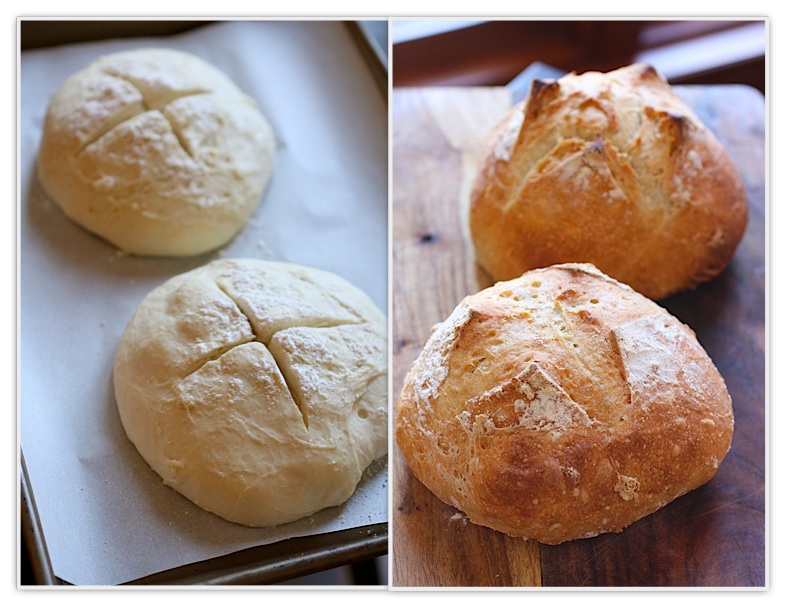
Boules Rising and Boules after Baking
The key is mixing up a high moisture, or "slack" dough, and letting it do a long fermentation in the refrigerator. It's long been known that a long fermentation contributes flavor to dough but it seems it also develops gluten and eliminates the step of kneading. The advantage in using refrigeration is that you can control the fermentation and you can make up a large batch of dough, enough for four loaves, and keep it in the fridge. If you make a very wet dough, it will be able to last in the refrigerator a long time, gaining flavor as it ferments and allowing you to make bread whenever you decide. This is not to say there is not a place for multi-stage, time-consuming bread making techniques which require 15 minutes of kneading - I love making my homemade focaccia, which takes three rises every time I make a batch. But this bread is absolutely a no-brainer. You mix up a big batch of dough in one container, a process which takes only a couple of minutes (remember, there is no proofing of yeast or starters to make). When you want bread, you cut off a hunk of dough and shape it. You can make various sizes and shapes: boules, batards, rolls or baguettes. It's just so convenient and makes such a beautiful bread with a crackly crust, you won't believe it. I've even shaped the dough into rolls. Peter Reinhart points out that the home baker has an advantage over the commercial baker with this technique - the commercial bakery does not have the refrigeration space to use a method like this. As a home baker, we can make up small batches of dough, refrigerate it and enjoy fresh bread whenever we want it. If you are buying fresh bread three times a week at $4.00 per loaf, you are spending about $50 a month on bread! This bread is only about 40 cents a loaf to make. And, since bread is best the day it is made, you don't have to drive to the grocery/bakery to get it every time you want a loaf.
To see how easy it is to get a loaf ready, you can watch me form a loaf in about 30 seconds:
This bread is very versatile, also. In both Peter Reinhart's book and Jeff Hertzberg and Zoe Francois' book, they give you many variations of breads made with the master bread recipe in each book. You can make whole wheat breads, cheese breads, herb breads, breads stuffed with sun dried tomatoes, Challah, Semolina Bread and on and on. Jeff Hertzberg and Zoe Francois have come out with another book, "Healthy Breads in Five Minutes a Day", for people who would like more whole grain recipes and gluten free breads. This is a great book, too, and has lots of wonderful ideas in it. I have all three books and strongly recommend them if you want to try easy bread making. It's nice to be able to make bread whenever the whim hits you - I have several types of doughs in my refrigerator, happily fermenting away.
In these recipes, instant yeast is used, which eliminates the need for "proofing" the yeast. Everything is simply mixed together. If you are interested in learning more about yeast, my recent "Yeast Explained" post may be of interest to you. Instant yeast is sometimes labeled "fast acting yeast" and is sold under the names of "Rapid Rise" and "Quick Rise" yeast. Also, Bread Machine yeast is simply instant yeast. I like to buy my yeast in the little jars instead of the packets because I can use only as much as I need out of the jar and it tends to be cheaper.

One way of letting the dough rest and rise is to place it on a pizza peel, dusted with some cornmeal. This works well when we make pizzas and pop them right into the oven. However, for this the bread seems to stick because you have to let it sit so long on the pizza peel and rest. So I place a small square of parchment paper on the pizza peel and put the dough right on that. When I slide it into the oven, it goes in along with the parchment paper and bakes up beautifully. If you want an extra crispy crust, just remove the parchment paper halfway through the baking time and return the bread to the pizza stone - this is what I do.
The dough can be stored in any plastic container with a lid or a bowl with plastic wrap placed over it. You want the gases to be able to escape as the dough rises, though - so wrap the plastic wrap over the bowl tightly and then puncture a little hole in the top. It is nice to have a dedicated plastic container, though, in the fridge for your dough, because you are going to just keep it in there all the time. Although these containers are recommended by the authors and the King Arthur Flour website has these nice dough rising buckets, I bought a square plastic-lidded container at my local grocery store because I thought it fit in my fridge better. You can see it in the photos below. I place the lid on tightly, but I punched a small hole in the top. This is important to do.
So get out a bowl if you don't have a plastic container, mix up a batch of dough and have your first loaf tomorrow. You won't believe it.
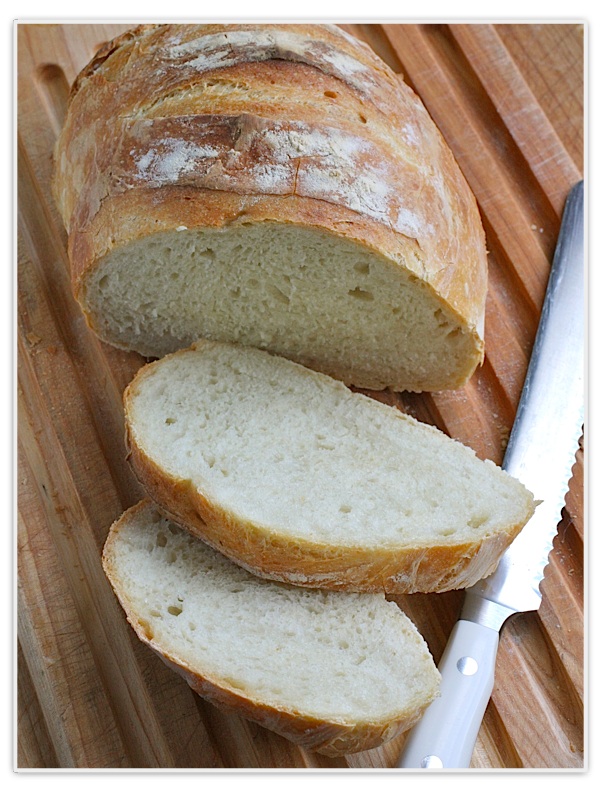
No Knead Artisan Bread
adapted from Artisan Bread in Five Minutes a Day
for a printable recipe, click here
makes four 1 pound loaves.
Ingredients:
- 3 cups lukewarm water
- 1½ tablespoons granulated fast acting (instant) yeast (2 packets)
- 1½ tablespoons kosher or other coarse salt
- 6½ cups unsifted, unbleached all purpose white flour*
(My favorite way to make this bread now is to use half bread flour, half all-purpose flour and throw in ½ cup wheat bran into the dough.)
*After baking, if your bread is gummy on the inside, try either increasing the amount of flour by ½ cup and/or increasing the baking time by 10 minutes.
Instructions:
Mixing and Storing the Dough
1. Warm the water slightly. It should feel just a little warmer than body temperature, about 100 degrees F. Warm water will rise the dough to the right point for storage in about 2 hours.
2. Add yeast and salt to the water in a 5 quart bowl or a plastic container with a lid.
3. Mix in the flour - kneading is unnecessary. (Note: I dump all this in my KitchenAid mixer, let it mix it for just about 10 seconds and then put it in the plastic container. I just find it easier to let the mixer do this part). Add all of the flour at once, measuring the flour by scooping it and leveling it off with a knife. Mix with a wooden spoon - do not knead. You're finished when everything is uniformly moist, without dry patches. This step is done in a matter of minutes. The dough should be wet and loose.
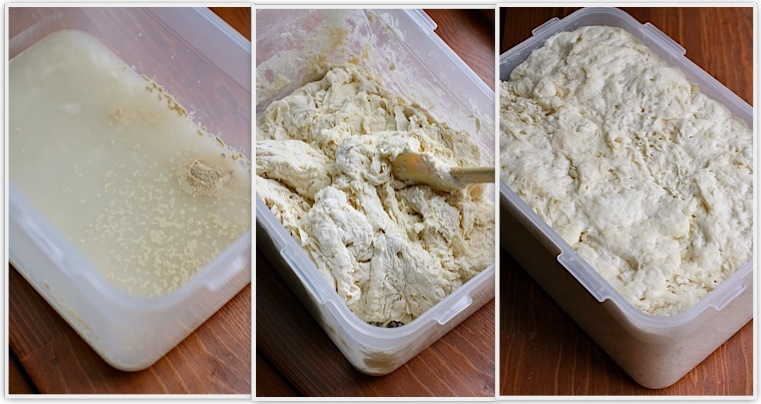
4. Allow to rise. Cover with a lid (not airtight). Lidded plastic buckets designed for dough storage can be purchased many places. (I used a plastic square food storage container I got at my local grocery store. I now use a Rubbermaid 21-cup Dry Food Container. I punched a hole in the top). You want the gases to be able to escape a little. Allow the mixture to rise at room temperature until it begins to collapse (or at least flattens on top), about two hours. Longer rising times will not hurt your dough. You can use a portion of the dough any time after this period. Fully refrigerated wet dough is less sticky and is easier to work with than dough at room temperature. So, the first time you try this method, it's best to refrigerate the dough overnight (or at least 3 hours) before shaping a loaf.
Baking
5. Shape your loaf. Place a piece of baking parchment paper on a pizza peel (don't have a pizza peel - use an unrimmed baking sheet or turn a rimmed baking sheet upside down). Sprinkle the surface of your dough in the container with flour. Pull up and cut off about a 1-pound piece of dough (about the size of a grapefruit), using scissors or a serrated knife. Gently stretch the surface of the dough around to the bottom on all four sides, rotating the ball as you go. Dust your hands with flour if you need to. This is just to prevent sticking - you don't want to incorporate the flour into the dough. The top of the dough should be smooth - the object here is to create a "gluten cloak" or "surface tension". It doesn't matter what the bottom looks like, but you need to have a smooth, tight top. This whole step should take about 30 seconds! Place the dough onto your parchment paper.

6. Let the loaf rise for about 30 - 40 minutes (it does not need to be covered). If it doesn't look like it has risen much, don't worry - it will in the oven. This is called "oven spring".
7. Preheat a baking stone on the middle rack in the oven for at least 20 minutes at 450 degrees F. Place an empty rimmed metal baking pan or broiler pan on a rack below the baking stone. This pan is for holding water for steam in the baking step. (If you don't have a baking stone, you can use a baking sheet, but you will not get the crisp crust on the bottom. You will still have a great loaf of bread. Baking stones are cheap and easy to find - Target carries them - and are a must for making pizzas, so go out and get one as soon as you can.)

8. Dust the loaf with a little flour and slash the top with a knife. This slashing is necessary to release some of the trapped gas, which can deform your bread. It also makes the top of your bread look pretty - you can slash the bread in a tic tac toe pattern, a cross, or just parallel slashes. You need a very sharp knife or a razor blade - you don't want the blade to drag across the dough and pull it. As the bread bakes, this area opens and is known as "the bloom". Remember to score the loaves right before baking.
9. Bake. Set a cup of water next to your oven.* Slide the bread (including the parchment paper) right onto the hot baking stone. Quickly pour the water right into the pan underneath the baking stone and close the oven door. This creates the necessary steam to make a nice crisp crust on the bread. Bake at 450 F for about 30 - 35 minutes, depending on the size of your loaf. Make sure the crust is a deep golden brown. When you remove the loaf from the oven, you will hear it crackle for a while. In baking terms, this is called "sing" and it is exactly what you want.
* update: I have recently begun skipping this step with the water. I believe it caused my oven window to eventually crack and I have found that my bread is still great even without the water. If you want an extra crispy crust, though, it is worth doing once in a while
10. Cool. Allow the bread to cool for the best flavor and texture. It's tempting to eat it when it's warm, and that's fine, but the texture is better after the bread has cooled.
11. Store the remaining dough in the refrigerator in your lidded (with a hole punched in the top) container and use for up to 14 days. Every day your bread will improve in flavor. Cut off and shape more loaves as you need them. When your dough is gone, don't clean the container. Go ahead and mix another batch - the remaining bits of dough will contribute flavor to the next batch, much like a sourdough starter does!
Bread is best eaten the day it is baked. Leftover baked bread is best stored at room temperature, unwrapped. Simply place the cut side of the bread on plate or counter. If your bread is gummy on the inside, try either increasing the amount of flour by 1/4 cup and/or increasing the baking time by 5-10 minutes.
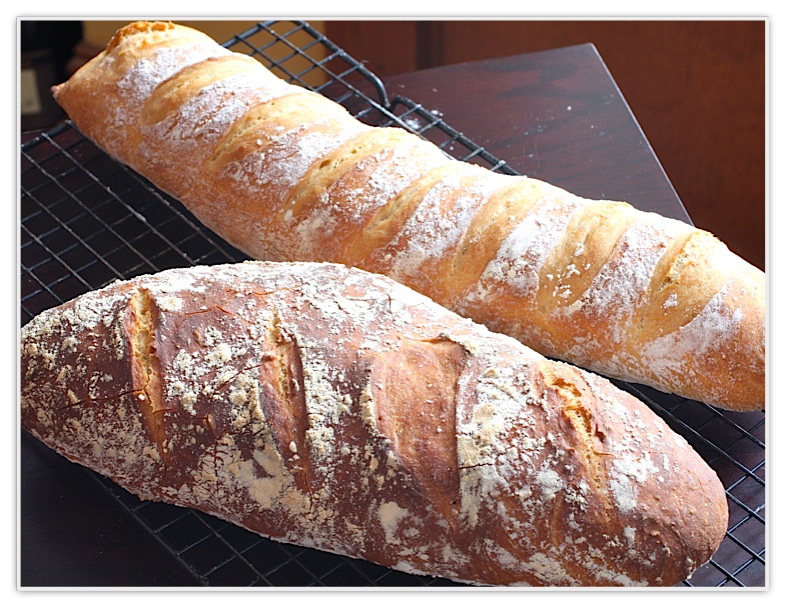
Check out the Artisan Bread in Five Minutes a Day website - Jeff and Zoe have great tips and recipes over there.

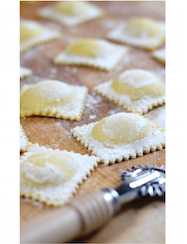
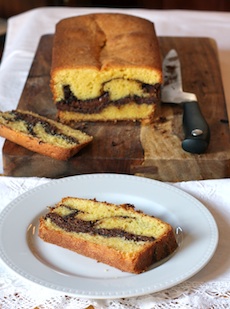
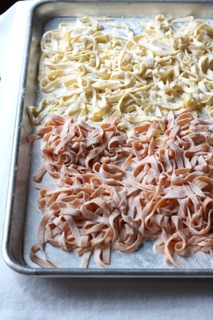
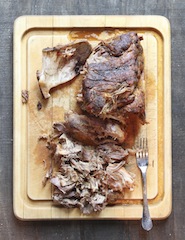
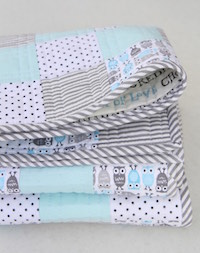
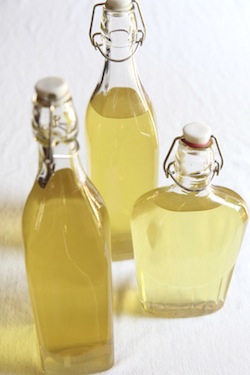
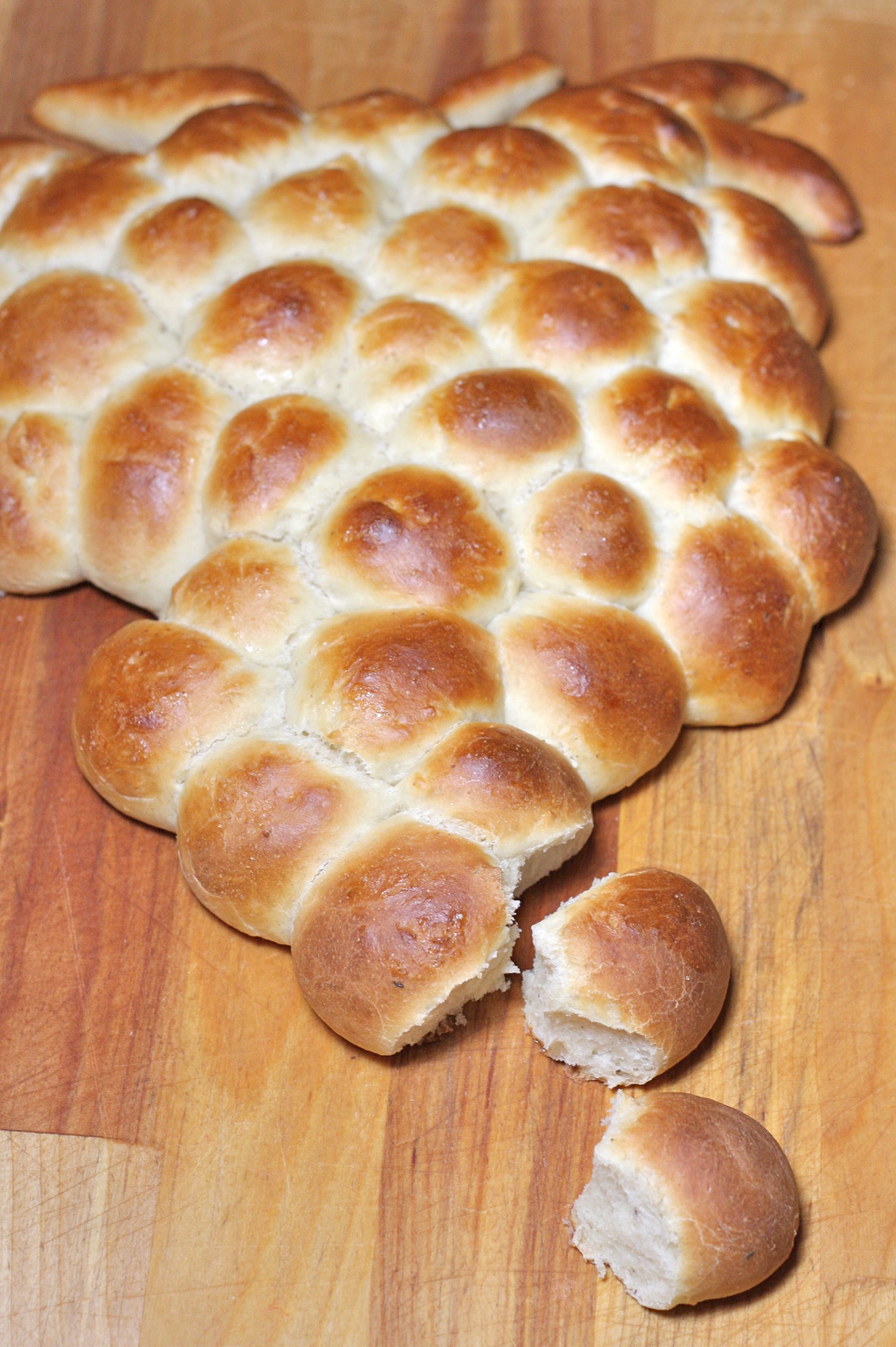

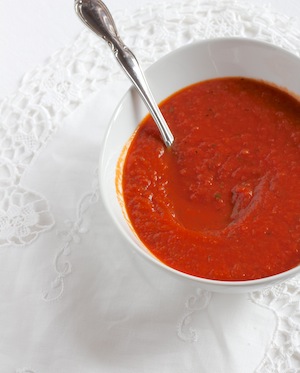
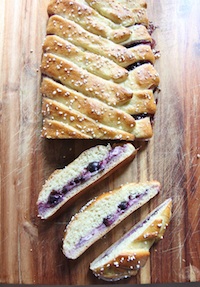

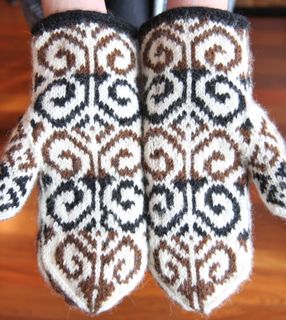


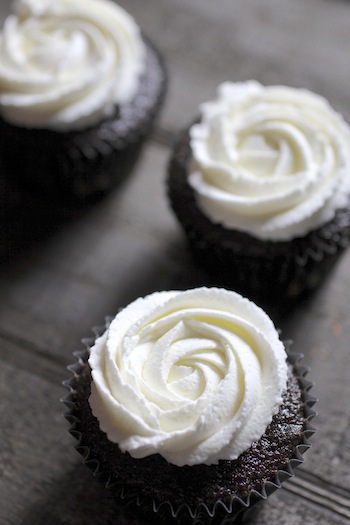



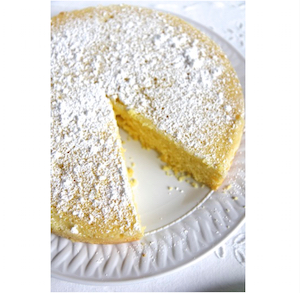
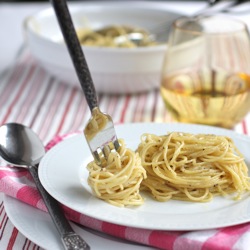


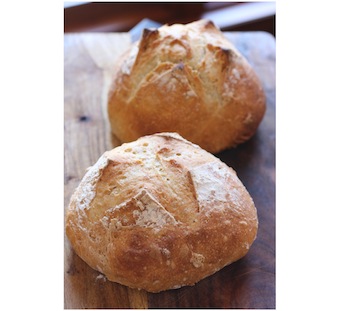
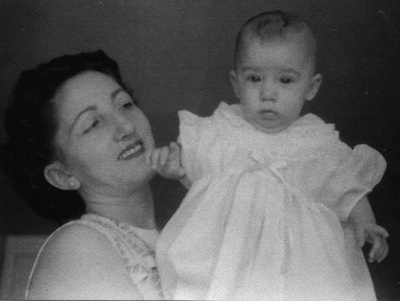

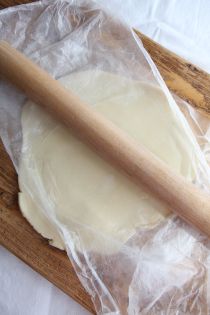

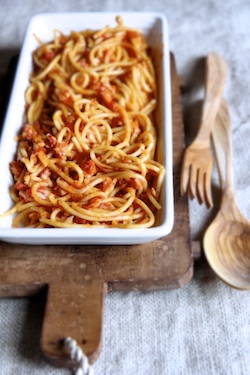
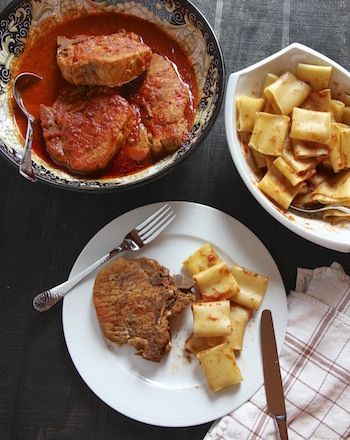









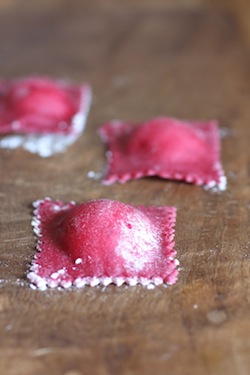

Reader Comments (468)
From The Italian Dish:
Manu: No! In fact, I mentioned this in the post - the longer the bread sits in the fridge, the more of a sourdough taste it will get. That is an added benefit and that is one thing I like about this method. Enjoy your bread!
Made this 2 days ago and it was the easiest and most fantastic loaf I ever made. Today I made a loaf from what was leftover dough stored in fridge. It came out even better. This is the only way I'll make bread from now on.
Thank you!!! After making a "disaster dinner rolls" I was so afraid to try another bread recipe. But after reading your blog, watching your video, reading the recipe, watching more videos, and reading the recipe again, I finally got the courage to do it (it took me 3 days to gain confidence)! I was almost sure I made a mistake because [1] I was not sure if the water was warm enough or if it was too hot and [2] the dough was not wet and sticky - it was dry so I added a few more splash of water. I cannot wait until tomorrow so after the initial 2 hours rising, I baked 1 loaf. And it was sooo good!!! I cannot believe I did it! Thank you so much! I don't have a baking stone so I just used a regular pan and it still turned out to be really crusty which I really like! :)
From The Italian Dish:
Yang: Only worry if the water is too hot (it will kill the yeast). Also, your dough should not be dry - be sure the flour measurement is correct and be sure to stir everything thoroughly. I'm glad you like the bread - it will only get better as the dough sits in the fridge.
I made 1 loaf again this morning after keeping it in the refrigerator overnight. However, my dough did not rise before baking and did not "bloom" during baking. Any suggestion? Thank you!
From The Italian Dish:
Yang: Did you let the dough rise in a warm place? It won't look like it rises a lot, but when you bake it, it should puff up. I don't know why it did not do that. Was the oven hot enough? Make sure it is at 450 degrees F.
Thank you for your reply! It's probably because the kitchen was a little cold - early morning in November. So I will try this again and hopefully I get better results with more practice :)
Wow! I can't believe I just made bread that is as pretty as your pictures. It tastes divine. The crispy crust is perfect. And I barely did anything to make it happen... Thank You so much for posting it with such great instructions. If you hadn't put that little movie up I might have chickened out. Now I will be making it all the time and everyone will love me!
I soooo love making bread and sometimes it can be a pain doing the kneading , So I can't wait to try this bread.thanks.
I made a batch of this with part wheat and part white flour and it turned out perfectly. Last night I mixed up a batch using all white flour and it is very sticky/wet and hard to handle. Is there any way to fix this now that I've let it rise on the counter and put it in the fridge over night? Thanks for your help!
From The Italian Dish:
Kari: Next time you make the dough, add 1/4 cup more flour - it will be easier to handle, if you are having some trouble with that. As for the batch you have now, either wet your hands a little bit or flour them well before shaping the loaf. This will help with the stickiness. Hope this helps.
Thanks so much! I baked some tonight and it was still very good even though it was awfully wet. :) I love this recipe and can't wait to get the book so I can try other variations! Thanks!
My wife an I made this bread today and it was fantastic! The finished loaf looked exactly like the photo. When I shaped the loaf I noticed that the dough was VERY cold because it had been refrigerated overnight, so we needed to let it rise for a couple of hours, and we had to move it to a warmer place. We placed a big plastic dome over it (from the popcorn popper) so it wouldn't dry out. There were holes in the top of that dome so it worked perfectly. We also needed to add another 1/2 cup of water when mixing the dough to get it to the right consistency. It was WAY too dry. Perhaps this is because we used bread flour, not AP. But the main reason I'm posting here is to thank you for this article. Your video, especially, was extremely helpful because it showed exactly how to form the loaf. Thank you!
Hi Elaine, I tried making this bread just now (made the dough yesterday) and they are delicious! I have a few questions for the next batch in order to make it better:
- Since we live in Singapore where the humidity level is quite high, would you suggest we add a little more flour so the dough and bread is less wet? If so, how much more for one recipe?
- We don't have a pizza stone and bake just on a cookie sheet with parchment paper. Do we still need to have water in the oven?
Thanks!
From The Italian Dish:
Yosita: There is no need to add more flour to the dough unless you feel that the dough is not baking up properly or if you feel it is way too sticky to work with. As for the water in the oven I actually don't do this every time I bake the bread. I've gotten a little lazy about it! My bread still comes out crispy. I always bake on a baking stone, though. If the bread is crispy enough for you, don't worry about the water.
Hi Elaine, thanks for the clarification. I baked my first bread with water in the oven and the crust turned out crispy and a bit hard. So maybe next time I'll just do it without the water and hopefully get a softer outer layer. Thanks for posting this recipe, I knew there was a no-knead recipe that actually works! :)
I made this last week and it was terrific! Wondering how much if I can add sour dough starter to this and how much. I want to make turkey stew in bread bowls! thanks for any help you can give me.
I had a complete failure. I didn't bother to measure the yeast from the 1/4 oz pkg. My dough is way too wet. LIke it needs another 2 cups of flour. I live outside of the US so, I will have to read up on the difference between rapid rise yeast and reg yeast, since I used up the pkgs I brought from my last US visit. But I will try again because the reviews on this recipe can't be wrong!
Another thought. Because I am at over 8,500 ft altitude, should I increase the amt of yeast + flour?
Thanks!
From The Italian Dish:
Steph: No need to add sour dough starter to this. If you make the dough far enough ahead of time, it takes on a sourdough tang.
MD White: Please try again - maybe you measured the flour or water wrong? The dough is supposed to be a bit wet - much wetter than a normal dough. Also, a post that I wrote about yeast is worth reading - it will explain to you what the different yeasts are:
http://tinyurl.com/yb753n3
As for high altitude cooking, I have never had to do it and am not familiar with it. I'm sure if you Google it, you can find advice on how to adjust for baking.
Hope this helps and try again!
Hi Elaine! I was so excited to make this bread and it was quite fun. The only problem I had was shaping my bread. Every time I touched the dough, it stuck tony hands like a magnet. The dough was refrigerated overnight and I even dusted my hands with flour. I don't know what to do to get it rolled up nicely with a tight top because every time I try to pull my hands away, I ruin my shaped dough and it ends up looking like a really thick pancake. What should I do? Would it be bad to use oil to grease. My hands?
Thank you! ~Kirie
From The Italian Dish:
Kirie: next time you make the dough, add 1/4 cup more flour to it and I guarantee it will be easier to work with. Hope this helps.
why is there no sugar in this recipe ..any particular reason?
Bread making is a new thing to me, but I'm excited to try. Can I replace the flour with wheat flour? Will I need to change anything else? Thanks!
Tried your fantastic bread and it was great. Have tried a no knead dutch oven bread in the past and this was a little better. It has taken us a long time to get a perfect bread that is not too dense but still with a crispy crust. We did think that this recipe could use less salt than is mentioned ( maybe only 1 tablespoon instead of 1 and a half ). When i baked the bread i actualy tried using two methods, one with the pizza stone with the water underneath, and the other in a cast iron caserole dish. I have to say the difference in the two was remarkable. Both were good, but i have to say using either a cast iron dutch oven or a caserole dish (with the lid on of course) locks the steam in which is the secret to a great crusty bread. We did ours for 30 mins with the lid on then a further 10 mins without the lid to male the bread golden. Works a treat. Both were great but give both a try. Each to there own. Thankyou we will be trying a lot of your recipes.
Hi!
I have made this bread about half a dozen times now. Mostly, it has come out good (a few times the inside was a bit gummy so I tried adding extra flour as suggested). The bottom of my bread is not getting as crispy as I would like it. Do you have any suggestions?
I had the same problem so the last 5-10 mins. I turn the loaf over in the oven. It helped and also took care of some of the doughiness
I am definately making this bread! I have NEVER had homemade bread before and I really don't like storebought bread!
I was wondering if there were any spices or seasoning that would go well inside this.
Thank you so very much!
Wonderful bread. I usually buy my Artisan bread at VG's supermarket but no more ... love the chewy crust and the wonderful taste. It is so easy.
When my husband and I visited our son's family in GA. Kerry, our daughter in law, made this bread. She is such a good cook and when she made this bread, it topped off the meals she made for our visit. She told me about this web site and gave me the recipe. Thanks so much to Kerry for turning me on to this site. I love it!
Thanks so much Elaine! The bread is fantastic!
Made this yesterday for the first time. Couldn't have been easier, and it was soooo good! We had exchange students from Denmark and German as dinner guests, and they were raving about the bread. The highest compliment....
I made bread. I MADE BREAD. I, the complete baking failure, made DELICIOUS BREAD.
Not only that, but my ultra-picky "Everything is yuckyyy!" three-year-old ate a piece. AND LIKED IT.
A million thanks for sharing the recipe. (And for the books being added to my wish list.) You rock.
Just wondering how big of a hole to drill in my lid! Love this recipe so I bought the bucket from amazon. I use one for my pizza dough and one for this bread dough.
my bread didn't seem to rise and was like a puck -- maybe too wet????
Thank you so much for posting this and making it so easy to follow!
I ended up with a dry dough since I did not measure very carefully so I added about 1/4 cup of water. I also did not have the instant yeast so I just proofed what I had. I let it sit on the counter for three hours so it was bigger than I was expecting.
But after three hours in the fridge, I just made the best bread ever! All of my other attempts before were failures but now I am eagerly waiting for my husband to get home and be wowed :)
I will be investing in a pizza stone and a container or two dedicated to dough and the book so I can try more recipes.
Thank you so much and I am really looking forward to looking through more of you beautiful blog!
Anyone else find it a bit salty? That notwithstanding.......not bad.
Hi,
I'm a real amateur baker. I've tried baking breads in the past and they always came out boring, bland, and very dense. After lots of research, it seems that my breads just aren't forming enough gluten. Anyway, I came across your post and I was very skeptical that such an easy recipe could really produce perfect bakery/restaurant bread. I just tried it and OH MY GOD! This really does come out amazing. I followed the instructions almost to the letter. (I don't have a pizza stone so I used a baking sheet, and I didn't have parchment paper so I used aluminum foil. Otherwise I tried to make sure I did everything exactly as you said). I practically ate the entire first loaf all by myself.
Thank you so much for posting this! This one is definitely a keeper!! I cant wait to bake up another loaf tomorrow. For other amateurs out there - don't be intimidated. Just try it. It really does come out perfect.
Thanks so much for sharing the details of the wonderful recipe. I am trying it for the first time this morning. My dough was mixed last night and placed in the fridge for approximately 18 hours. This morning I tried shaping the dough but it was so sticky. Wish I had watched the video again before starting. I think I must dust with more flour on the dough itself. I floured my hands but this was not enough. Regardless, I think I got it shaped with the gluten cloak look and I will be putting 2 loaves in the oven in about 25 minutes after resting for a total of 40 minutes. I am so excited. I will let you know how it turns out. These loaves are being prepared for a Sunday dinner of Baked Mac & Cheese and lots of family. Hope you have a wonderful day. Oh, there goes the timer, it is now time to preheat the pizza stone for 20 minutes. Bye for now.
A recent post by Sherian indicated that she used a cast iron casserole rather than a pizza stone. Would I have to preheat the casserole much like the pizza stone before I placed the dough in it. Would the dough need to be on a piece of parchment paper. Just wondering. I would love to try the casserole idea.
I just read a post by someone named Lee. This is the only way I can contact him/her so please excuse me. Lee, nowhere on these pages did the lady say all these were her recipes. Most times she'll tell you where they came from if you bother to read the whole article. She has taken the trouble to compile these recipes and put them on line for others to use so we don't have to search for a good one. Say thank you not this one came from this book or that book. Try ingrates.com for more of your ilk.
Have a nice day Lee.
Breads out and looks lovely. Quite small though. Thought that 2 loaves would feed my gang of about 10 adults and a couple children but I will have to rethink this. They look a bit wonky but that is because I need to work on my technique. The smell is wonderful. I will now be patient and let them cool.
Breads out and looks lovely. Quite small though. Thought that 2 loaves would feed my gang of about 10 adults and a couple children but I will have to rethink this. They look a bit wonky but that is because I need to work on my technique. The smell is wonderful. I will now be patient and let them cool.
Pat,
When you use a cast iron caserole dish, yes you need to preheat the dish in the oven first. I always put the dough on baking paper first. That way it wont stick to the pan at all and if you have a big dish like we do, you can do more than one loaf at once. We normaly use our camping Dutch Oven or our cast caserole dish. Good luck, ours is always good.
Sharian, thanks so much for your reply and instruction. I too have a large cast iron casserole and will be excited to put dough for 2 loaves in it and see what happens. The bread was delicious that I made yesterday and got rave reviews by all, regardless of how weird it looked. Thanks again. Have a great day. You gave me a great idea for cooking this bread while camping, I wonder if I could keep the fire at an even temp. Have you tried this?
Has any body tried this method with sourdough?
Elaine, I understand what you mean about it taking on a sourdough flavour, but where I live we can't buy instant yeast, so I always make sourdough (which I love).
I usually make the sourdough recipe from Breadtopia (another great site) but feel sure this could be adapted to sourdough too.
I'd love to hear anyone's thoughts.
Thanks for a really great blog, I really enjoy it!
Thanks for the recipe and all the extra info you gave... I made my first batch using your instructions on Sunday... it was great! Takes about 5 minutes to get it ready for the 2 hour rise time... the rest is just as easy... I did a few things wrong to avoid a trip to the store - such as the wrong flour (mine was pre-sifted and bleached) and i didn't have any parchment paper... BUT it was still tasty.. . I'm going to pick up the right stuff next time I'm at the store and just keep the dough in the fridge all the time. Thanks again!
Amey
I found your blog about a week ago, and it's changed my life! This no-knead bread recipe was my first foray into baking bread. My mom made delicious bread, but the thought of kneading it, watching it rise, punching it, and waiting for it to rise again was a bit intimidating. This bread is AMAZING! I can't believe I've been spending ridiculous amounts of money on artisan bread at the grocery store, when I could be making it at home with virtually no effort at all. Thanks! If you could give a little guidance on add-ins, though, that would be terrific...a little rosemary, a little garlic, etc., would be fun. I'm looking forward to trying many more of your recipes!
I have 2 loaves in the oven right now!!! I hope they turn out !!
I'll keep you posted :)
I came across this recipe via Pinterest, and my family is in love with this bread! I can't imagine the dough lasting anywhere near 2 weeks, because we would eat it up long before that! I made my first batch of dough yesterday, and I already had to refill the dough tub today with another batch. ;) I can't wait to experiment with herbs, pesto, cheese, roasted garlic....
This is delicious, EASY, and cheap. Perfect combo.